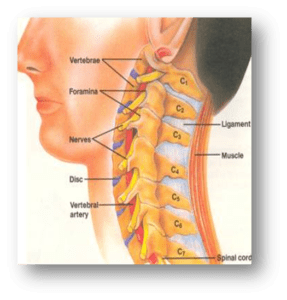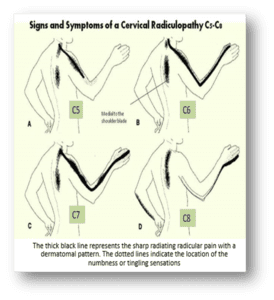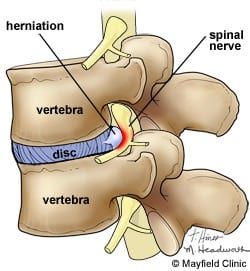 Background:
Background:
Radiculopathy refers to disease or injury of the spinal nerve roots resulting in radicular pain, weakness, numbness and/or tingling in the arms. Pain may be felt in a region corresponding to a dermatome, an area of skin innervated by the sensory fibers of a given spinal nerve. There are cervical (neck), thoracic (middle back), and lumbosacral (lower back) radiculopathies depending on the location of the injury. Radiculopathies are further categorized by what level of vertebrae they are associated with, therefore if the injury is at the neck region, the term cervical radiculopathy is used, if the injury is at the lower back, the term lumbosacral radiculopathy is used and so on.
Functional Anatomy and Causes:
In the neck or cervical spine, there are seven cervical vertebrae and 8 cervical nerve roots exist from the cervical spine. Intervertebral discs are located between the vertebral bodies of C2-C7. The discs are composed of outer and inner fibrotic tissues and serve as a protective barrier between the vertebrae.
 Radiculopathies are categorized according to which part of the spinal cord is affected. For example, if the nerve root between the fourth and fifth cervical vertebrae is injured, the C5 nerve root will be pinched or strained, therefore the term C5 radiculopathy will be used. If the nerve root between the sixth and seventh cervical vertebrae is injured, the C7 nerve root will be pinched or strained, therefore the term C7 radiculopathy will be used, and so on.
Radiculopathies are categorized according to which part of the spinal cord is affected. For example, if the nerve root between the fourth and fifth cervical vertebrae is injured, the C5 nerve root will be pinched or strained, therefore the term C5 radiculopathy will be used. If the nerve root between the sixth and seventh cervical vertebrae is injured, the C7 nerve root will be pinched or strained, therefore the term C7 radiculopathy will be used, and so on.
Sympotms vary among patients, but radiculopar pain is typical. However, weakness, numbness and/or tingling in the arms are also felt in a region corresponding to a dermatome, an area innervated by the sensory fibers of the injured spinal nerve.
Most people will experience some form of radiculopathy at some point in their lives. The radiculopathy occurs more often in the middle-aged and elderly than in the young, with the highest risk being for adults 40 to 60 years year old. However, injuries due to sports, heavy lifting, or bad posture affect the young as well.
Radiculopathy can be caused by any disease or injury process that compresses or otherwise injures the spinal nerve root from trauma or falls, cancer, infections, diseases that lead to degeneration of the vertebrae and/or intervertebral discs (osteoarthritis), slipped or herniated discs, spine deformities (scoliosis), and other factors as well.
Diagnosis:
Patients with signs and symptoms that correlate to radiculopathy must have an electrodiagnostic study (Nerve conduction study and EMG) to confirm the diagnosis by a highly specialized and fellowship-trained neurologist such as Dr Yono and Dr Kashouty. Electrodiagnostic studies can help distinguish radiculopathy from other etiologies and is important in identifying physiologic abnormalities of the nerve roots and the muscles.
X ray or MRI may be used to confirm the diagnosis. MRI has become the method of choice for imaging the neck to detect significant soft-tissue pathology, such as disc bulge or herniation. The American College of Radiology recommends routine MRI as the most appropriate imaging study in patients with chronic neck pain who have neurologic signs or symptoms. MRI can detect ligament and disc disruption, which cannot be demonstrated by other imaging studies. The entire spinal cord, nerve roots, and axial skeleton can also be visualized.
All imaging studies must be used in conjunction with the patient’s history and physical examination findings to make the diagnosis of radiculopathy.
Treatment:
Treatment for radiculopathy varies with the nature and severity of the disease process or injury that has caused the disorder. Initial treatment should be directed at reducing pain and inflammation around the spinal nerve. The treatment can begin with local icing, medications to treat the pain such as nonsteroidal anti-inflammatory drugs (Ibuprofen, etc.), and measures that reduce the pressure on the nerve root. This consists of relative rest, avoiding positions that add extra strain on the neck. Patient-specific exercises are prescribed by a physical therapist for the targeted strengthening of neck muscles and other supporting tissues to relieve pressure on affected spinal nerve roots. A soft neck collar may be prescribed for persons with cervical radiculopathy if needed.
Epidural corticosteroid injections, selective nerve root block, and epidural lysis (destruction) of adhesions are considered as secondary treatment options to treat radiculopathy. Cervical epidural steroids have been used in patients whose conditions have not had satisfactory responses to medications, and a well-designed physical therapy program. Acupuncture has been used to treat radicular pain in conjunction with other treatments with some success.
When conservative treatment fails, spinal surgery may be needed. The primary purpose of surgery is to stop the progression of symptoms by relieving the pressure on the affected spinal nerve roots. Procedures may include laminectomy, discectomy and fusion which will be discussed in detail with the spinal surgeon. With appropriate indications, surgery can result in resolution of symptoms and excellent outcomes in the majority of patients.
Citations
Gilman, Larry. “Radiculopathy.” Gale Encyclopedia of Neurological Disorders. 2005.
Retrieved October 20, 2015 from Encyclopedia.com: www.encyclopedia.com/doc/1G2-3435200297.html
Malanga, Gerard M. “Cervical Radiculopathy”: Background, Epidemiology, Functional Anatomy. Medscape.
URL: emedicine.medscape.com/article/94118
Updated on October 8, 2015. Accessed on October 20, 2015.




